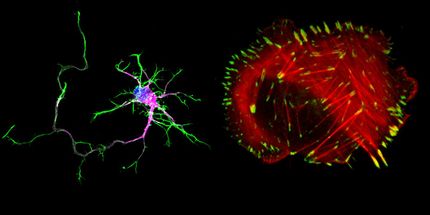Blocking cell distress signals can ease autism symptoms
Study opens promising new direction in autism research
Advertisement
autism Speaks announced a study supported by one of Autism Speaks' first Suzanne and Bob Wright Trailblazer Awards, presents a new theory that autism may result from chronic danger signaling by mitochondria, cell structures that supply our cells with energy. This study by Trailblazer researcher and mitochondrial medicine specialist Robert Naviaux, M.D., Ph.D., of the University of California, San Diego published in the journal PLOS-ONE supports a novel theory about the cause and potential treatment of autism. The theory is that a chronic "cell danger response" can interfere with brain development and function. Using a mouse model of autism, the researchers blocked the abnormal cell danger signals using a chemical compound. Doing so reversed the signs and symptoms of autism in the animal's brains and behavior.
In 2010, Autism Speaks awarded Dr. Naviaux one a Trailblazer award to test his theory that it might be possible to reverse autism by blocking chronic cell danger signaling. The Suzanne and Bob Wright Trailblazer Award program supports novel, "out of the box" research with the potential to transform the field of autism research.
"Breakthroughs in the development of new treatment approaches for autism are going emerge from innovative theories, and trailblazing research, like that of Naviaux's team," says Autism Speaks Vice President for Translational Research Robert Ring, Ph.D. "Although these findings still need to be expanded and confirmed before they make their way into clinical trials, this line of work emphasizes how Autism Speaks will leave no stone unturned in our search for ways to convert scientific innovation into applications that transform outcomes for individuals with autism."
Several years ago, Dr. Naviaux proposed that cell structures, called mitochondria, play a broad role in the development of autism. Mitochondria are best known for providing cells with energy. Dr. Naviaux looked beyond energy production to study the mitochondria's role in signaling when a cell is damaged or diseased. Under stress, cells release mitochondrial, or "purinergic," chemicals that normally remain inside the cell. When they leak outside a cell, these chemicals signal danger to surrounding cells.
"In essence, these signals warn other cells to harden their defenses," Dr. Naviaux explains. "This helps protect against cell-to-cell infection. However, it may also interfere with cell-to-cell communication."
Normally, healthy cells stop releasing these danger signals when an infection or other stress resolves. According to Dr. Naviaux's "cell danger response" theory, autism can result when a stress during early brain development triggers a chronic danger response. The stress that starts this chain of events can come from an environmental influence, a genetic problem or a combination of both, he proposes. The result is chronic brain inflammation and frayed connections between brain cells. "When the brain cells stop talking, so do children," he says.
Dr. Naviaux's team produced litters of mice that exhibited autism symptoms by mimicking a viral infection in their mothers during pregnancy. This "maternal immune activation mouse model" is well-known for producing mouse offspring with symptoms of autism and schizophrenia.
The researchers measured social behavior by giving the mice opportunities to spend time with either another mouse or a Lego block in adjacent wire chambers. They also tested motor coordination as the mice walked along a rotating rod. While female pups showed only mild impairments, the male pups showed a 50 percent reduction in socializing and a 28 percent reduction in motor coordination. The researchers then tested the male pups' response to treatment. When the mice were 6 weeks old (roughly adolescents), 84 received an injection of suramin, a chemical that blocks the mitochondria's extra-cellular signals. For comparison, another 84 mice received a dummy shot of saltwater. The suramin treatment restored socializing and motor coordination to normal levels. The researchers saw no such improvement in the mice injected with saltwater.
Later, the researchers examined the mice's brain tissue, looking for brain abnormalities associated with autism. These included abnormal cell connections (synapses) and high rates of cell death in an important class of neurons called Purkinje cells. They found elevated levels of all these abnormalities in the untreated mice. But they were not present in the mice treated with suramin.
In people, suramin can be used safely only for short periods, because it has potentially serious side effects. "Our hope was to test this compound first in mice, then in a small clinical trial that will use just a single dose to determine whether this class of drugs is a good direction for developing safe and effective treatments," Dr. Naviaux says.
"Autism Speaks is not endorsing the use of suramin at this time for treatment of ASD," added Dr. Ring. "This study is an interesting and important first step in the translational process from bench to bed side, seeking potential treatments to address the core symptoms of autism."




















































